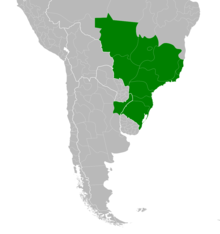Symphyotrichum regnellii (formerly Aster regnellii) is a species of herbaceous flowering plants in the family Asteraceae native to Argentina and Brazil.[1] It grows to heights of 60 to 120 centimetres, and its flowers have white to pink ray florets that have lengths up to 3 millimetres. It grows in swamps and wet savannas.[2]
| Symphyotrichum regnellii | |
|---|---|

| |
| Scientific classification | |
| Kingdom: | Plantae |
| Clade: | Tracheophytes |
| Clade: | Angiosperms |
| Clade: | Eudicots |
| Clade: | Asterids |
| Order: | Asterales |
| Family: | Asteraceae |
| Tribe: | Astereae |
| Subtribe: | Symphyotrichinae |
| Genus: | Symphyotrichum |
| Subgenus: | Symphyotrichum subg. Astropolium |
| Species: | S. regnellii
|
| Binomial name | |
| Symphyotrichum regnellii | |

| |
| Native distribution in green[1][2] | |
| Synonyms[1] | |

Distribution
editSymphyotrichum regnellii is native to Argentina and Brazil, specifically in the following jurisdictions. In Argentina, it is native to the provinces of Corrientes and Misiones. In Brazil, it is native to the states of Goiás, Minas Gerais, Paraná, Rio Grande do Sul, Santa Catarina, and São Paulo, as well as the Federal District.[3]
Citations
edit- ^ a b c d POWO 2019.
- ^ a b Sancho & Ariza Espinar 2003, p. 11.
- ^ Hassler 2021.
References
edit- Hassler, M. (8 October 2021). "Symphyotrichum regnellii (Baker) Nesom – World Plants: Synonymic Checklists of the Vascular Plants of the World". In Bánki, O.; Roskov, Y.; Döring, M.; Ower, G.; Vandepitte, L.; Hobern, D.; Remsen, D.; Schalk, P.; DeWalt, R.E.; Keping, M.; Miller, J.; Orrell, T.; Aalbu, R.; Adlard, R.; Adriaenssens, E.; Aedo, C.; Aescht, E.; Akkari, N.; Alonso-Zarazaga, M.A.; et al. (eds.). Species 2000 & ITIS Catalogue of Life, 9 November 2021. Leiden, Netherlands: Naturalis Biodiversity Center. ISSN 2405-8858. Retrieved 19 December 2021.
- POWO (2019). "Symphyotrichum regnellii (Baker) G.L.Nesom". Plants of the World Online. Royal Botanic Gardens, Kew. Retrieved 14 July 2021.
- Sancho, G.; Ariza Espinar, L. (2003). "Asteraceae part 16. Tribu: Astereae, parte B. Subtribus: Bellidinae–Asterinae (excepto Grindelia y Haplopappus)" (PDF). In Hunziker, A.T. (ed.). Flora Fanerogámica Argentina (in Spanish). Vol. 81. pp. 1–102. Archived from the original (PDF) on 13 July 2021. Retrieved 14 July 2021.